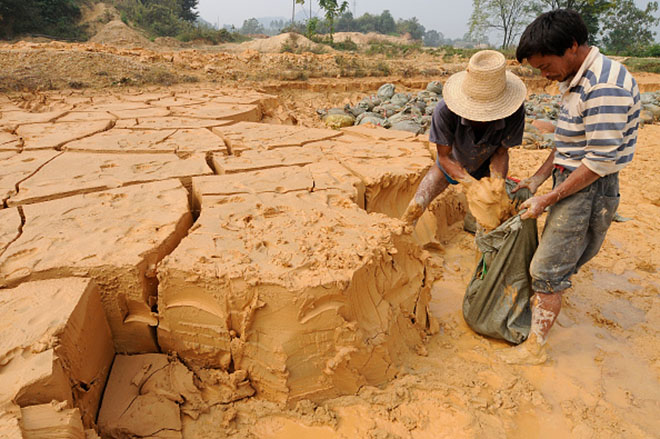
| China has long held a strong influence on the market for rare earths, but its share of global output and reserves has fallen significantly after years of extensive mining. Source: Jie Zhao/Corbis News via Getty Images |
The world’s reliance on China for rare earth elements has been gradually easing, but the country is expected to continue increasing production, exports and pricing for the commodity group through 2022, driven by increasing global demand for clean energy.
China has long held a strong influence on the rare earths market, but its share of global output and reserves has decreased after years of extensive mining. The rare earth elements comprise the 15 lanthanides as well as scandium and yttrium, many of which are essential for electric vehicles, magnets and other clean energy technologies.
“The upside trend [of China’s rare earths prices, output and exports] definitely will continue through 2022,” Yang Wenhua, a senior analyst with data provider Shanghai Metals Market, said in an interview. The global rare earths shortage could last until 2025 due to governments’ efforts to switch to low-carbon economies, Yang added.
Worldwide, the demand for rare earth elements could be three to seven times above current levels by 2040, according to the International Energy Agency.
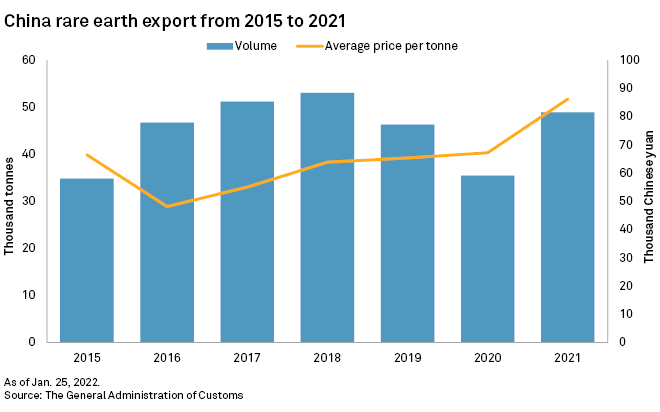
China recently lifted its rare earths mining output quota by 20% year over year to 100,800 tonnes for the first batch of 2022, against a backdrop of surging demand for renewable energy. The country announces quotas twice annually, including mining quotas for the more common light rare earths as well as the heavy rare earths.
Increased demand was reflected in a rare earths price index compiled by the Association of China Rare Earth Industry, which has jumped more than 85% from June 2021. Meanwhile, China’s exports of rare earths surged by 38% to 48,918 tonnes in 2021, the highest since 2018, data from the General Administration of Customs showed.
China is less likely to significantly increase its rare earths output quota, especially with heavy rare earths, due to environmental requirements and national strategy, Yang said. The quota for heavy rare earth elements has remained unchanged for more than three years. Heavy rare earth elements such as dysprosium and terbium are critical for defense and medical technologies, but the production process can be highly pollutive.
China’s rare earths exports are projected to grow 30% in 2022, while annual output will likely increase by 20%. Prices will also stay high in 2022, Yang said. Prices for neodymium and praseodymium oxides jumped more than 75% and 143%, respectively, as of Dec. 28, 2021, data from S&P Global Market Intelligence showed. Neodymium and praseodymium oxides are used in permanent magnets, a key material for EVs.
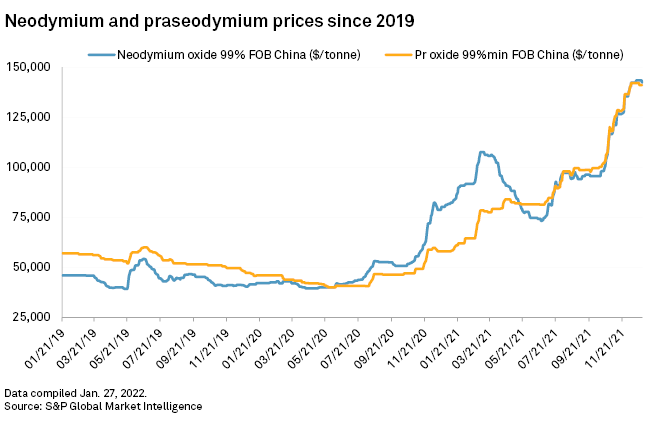
Changes in competition scope
“With the emergence of the worldwide rare earth exploration boom and the massive mining of China’s rare earth resources, China’s dominant position in rare earth resources has been gradually decreasing,” a group of researchers led by Zheng Guodong at the Chinese Academy of Geological Sciences wrote in a March 2021 essay.
China accounted for 60% of global rare earths production in 2021, down from 97.7% in 2010, according to the United States Geological Survey. Meanwhile, the country’s share of global reserves fell to 36.7% in 2020 compared to 50% in 2010.
Market participants in China are paying close attention to overseas rare earths supplies, which might be the biggest uncertainty for the domestic market for the longer term, Yang said. Among the newcomers, Africa is most likely to become a significant source of rare earths, according to the analyst. Despite limited capacity, Africa is the only region outside China that has built an entire industrial chain of electronic-waste recycling, Yang added.
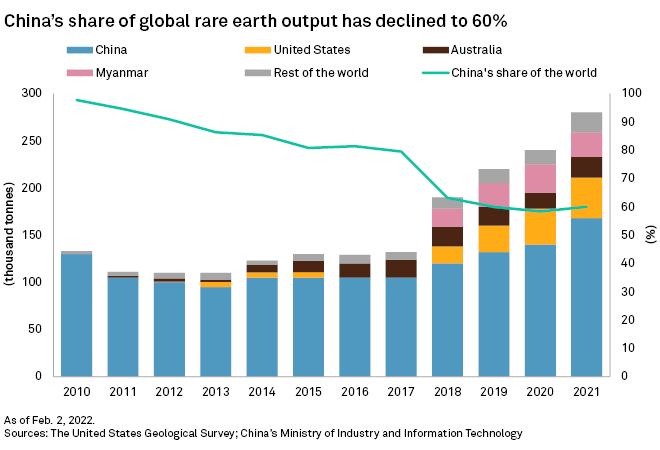
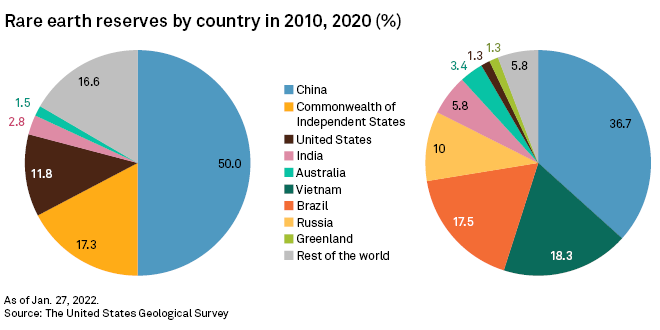
More companies will be recycling rare earths to meet decarbonization goals, according to Chen Shufang, an analyst at Chinese research firm Antaike. For example, neodymium magnet recycling accounts for about 30% to 40% of total supply, Chen said in an interview.
Long way to go
Chinese companies enjoy lower production costs, as their environmental requirements are still much looser than in many other countries, Yang said. More importantly, China spent decades developing a complete supply chain, covering upstream separation, smelting facilities and magnet plants as well as auxiliary materials such as phosphoric acid, sodium hydroxide and oxalic acid. China has also been working toward consolidating the rare earths industry to increase pricing power and improve management efficiency, Yang added.
Despite mounting global demand for rare earths, the path to launching a new refining facility in regions such as the U.S. is steep. Aspiring companies face myriad challenges including extensive permitting hurdles, a lack of available financing for upstream mining and refining projects, and strong competition with established producers in China.
Still, some North American companies are jumping into the market.
In California, MP Materials Corp. operates an integrated rare earths operation where it mines and beneficiates a mixed rare earth concentrate, which is ultimately sold to processors in China. The company does not process separated rare earths, but it is investing about $220 million to optimize separation circuits and produce a magnetic rare earth compound, bringing it a step closer to offering an end-to-end supply chain in the U.S., a spokesperson for the company told Market Intelligence.
MP Materials also announced in early December 2021 that it plans to develop a rare earths metal, alloy and magnet factory, with U.S. automaker General Motors Co. signing on as a foundational customer.
Other North American companies, including Energy Fuels Inc., USA Rare Earth LLC, Rare Element Resources Ltd. and Ucore Rare Metals Inc., have plans to undertake rare earths projects outside of China. However, bringing these projects to a commercial scale will take time.
It was not always this way, said Ian Lange, associate professor of economics and business at the Colorado School of Mines. Several decades ago, the U.S. had more refining capacity, but demand for rare earth products was too low for companies to justify keeping processing facilities up and running.
“If anyone thinks about building a refiner and tries to go get off-take agreements or commitments from, say, a U.S. firm to buy, companies in China can just come back and say, ‘Oh, we’re going to lower your price,'” said Lange, who also served as a senior economist on the Council of Economic Advisers for the Trump and Biden administrations. “That makes it really hard for domestic refining capacity to get into the financial market and say, ‘Hey, we’ve got promised buyers, so lend us some money to build this facility.'”
The U.S. government has flagged the country’s dependence on rare earth elements as a potential risk to national security, given the commodity group’s defense technology applications.
In February 2021, the U.S. Defense Department awarded $30.4 million to Australian rare earth element mining and processing company Lynas Rare Earths Ltd. to build a processing facility in Texas to strengthen defense supply chains. And in April 2021, the U.S. Energy Department doled out $19 million for 13 projects tied to rare earths and critical mineral production across the country.
More recently, U.S. Rep. Mike Kelly, R-Pa., and Sen. Tom Cotton, R-Ark., introduced legislation in January to bring rare earths processing back to U.S. shores. If passed, the bill would establish a strategic rare earths reserve and restrict the use of rare earth elements from China in advanced defense technology in the U.S., among other provisions.
However, similar proposals to reform the rare earths supply chains have stalled in Congress.
“My sense is [the issue is] still just too low profile,” Lange said.


